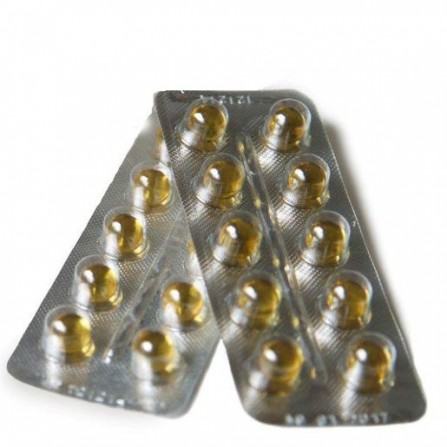More info
Description
soft gelatin capsules of spherical shape with a seam, from dark yellow to light brown, filled with an oily liquid from light yellow to dark yellow, without a rancid odor.
Active ingredients
Release form
Composition
per capsule:
active substances: retinol palmitate [Vitamin A-palmitate oil form, 1.0 million IU / g or 1.7 million IU / g (containing 1 g: retinol palmitate -
1,000,000 IU, butylhydroxytoluene - 10 mg, sunflower oil - up to 1 g or retinol palmitate - 1,700,000 IU, butylhydroxytoluene - 17 mg, sunflower oil - up to 1 g)] - 0.055036 g (100,000 IU), alpha tocopherol acetate - 0.1 g
(100 IU);
Excipients: sunflower oil (refined deodorized sunflower oil) - up to 0.2 g;
shell composition: gelatin - 0.036913 g, glycerol (glycerin) - 0.011865 g, methyl parahydroxybenzoate (nipagin) - 0.000264 g, instant coffee - 0.000958 g.
Pharmacological effect
Pharmacodynamics. Replenishes deficiency of retinol and vitamin E.
Retinol (vitamin A) is necessary for bone growth, normal reproductive function, embryonic development, for regulating the division and differentiation of the epithelium (enhances the division of epithelial skin cells, rejuvenates the cell population, inhibits keratinization processes). Vitamin A is involved as a cofactor in various biochemical processes.
The function of alpha-tocopherol (vitamin E) remains unclear to the end. As an antioxidant, inhibits the development of free radical reactions, prevents the formation of peroxides that damage cell membranes, which is important for the development of the body, the normal function of the nervous and muscular systems. Together with selenium inhibits the oxidation of unsaturated fatty acids (a component of the microsomal electron transfer system), prevents hemolysis of erythrocytes. It is a cofactor of some enzyme systems.
Pharmacokinetics
The drug is well absorbed from the digestive system. With the flow of lymph and blood is transported to organs and tissues. Excess vitamins A and E accumulate mainly in the liver. In unchanged form, vitamins A and E can be excreted into the intestinal lumen with bile, in a modified form they are excreted with urine and feces.
Indications
Combined vitamin A and E.
Contraindications
Hypersensitivity, hypervitaminosis A and E, pregnancy and lactation, child age (up to 14 years).
Precautionary measures
Thyrotoxicosis, cholecystitis, conditions associated with increased vascular permeability (chronic heart failure, chronic glomerulonephritis, etc.), cirrhosis of the liver, viral hepatitis, renal failure, alcoholism, old age, hypoprothrombinemia (amid vitamin K deficiency - may increase with the dose of vitamin E more than 400 IU).
Use during pregnancy and lactation
The drug is contraindicated during pregnancy and during breastfeeding.
Dosage and administration
Inside, regardless of the meal, daily 1 capsule per day.
The duration of treatment is 20-40 days.
Side effects
Allergic reactions (including skin rash), pain in the epigastric region, dyspepsia (nausea, vomiting, diarrhea). With prolonged use in large doses, possible exacerbation of cholelithiasis and chronic pancreatitis.
Overdose
Symptoms of an acute overdose of vitamin A (develop 6 hours after administration):
hypervitaminosis A: in adults - drowsiness, lethargy, diplopia, dizziness, severe headache, nausea, severe vomiting, diarrhea, irritability, osteoporosis, gingival bleeding, dryness and ulceration of the oral mucosa, peeling of the lips, skin (especially the palms), excitement, confusion.
Symptoms of chronic vitamin A intoxication: anorexia, bone pain, cracks and dry skin, lips, dry oral mucosa, gastralgia, vomiting, hyperthermia, asthenia, headache, photosensitization, pollakiuria, nocturia, polyuria, irritability, hair loss, yellow-orange spots on the soles, palms, in the area of the nasolabial triangle, hepatotoxic effects, increase in intraocular pressure, oligomenorrhea, portal hypertension, hemolytic anemia, changes on radiographs of bones, convulsions; phototoxic effects: in humans - malformations of the urinary system, growth retardation. Early closure of the epiphyseal growth zones.
Symptoms of an overdose of vitamin E: when taken for a long period in doses of 400-800 IU / day - blurred vision, dizziness, headache, nausea, diarrhea, gastralgia, asthenia; when taking more than 800 IU / day for a long period - an increase in the risk of bleeding in patients with hypovitaminosis K, impaired thyroid hormone metabolism, sexual dysfunction, thrombophlebitis, thromboembolism, necrotic colitis, sepsis, hepatomegaly, hyperbilirubinemia, renal failure, hemorrhage in the network, eye shell, hemorrhagic stroke, ascites.
Treatment: drug withdrawal; symptomatic therapy.
Interaction with other drugs
Vitamin A weakens the effect of calcium preparations, increases the risk of hypercalcemia.
Kolestiramin, Kolestipol, mineral oils, neomycin reduce the absorption of vitamin A and E (you may need to increase their dose).
Oral contraceptives increase the concentration of vitamin A in plasma.
Isotretinoin increases the risk of vitamin A intoxication.
The simultaneous use of tetracycline and vitamin A in high doses
(50 thousand IU and above) increases the risk of developing intracranial hypertension.
Vitamin E enhances the effect of glucocorticosteroids, nonsteroidal anti-inflammatory drugs, antioxidants, increases the effectiveness of vitamins A, D, cardiac glycosides. Prescribing high doses of vitamin E can cause a vitamin A deficiency in the body.
The simultaneous use of vitamin E in a dose of more than 400 IU / day with anticoagulants (coumarin and indandion derivatives) increases the risk of hypoprothrombinemia and bleeding.
special instructions
In order to avoid the development of hypervitaminosis A and E, do not exceed the recommended doses.
When using the drug should take into account the high content of vitamin
on A (100 thousand IU), and also that it is a curative, not a prophylactic drug.
A diet with a high content of selenium and sulfur-containing amino acids reduces the need for vitamin E.
Influence on ability to steer vehicles, mechanisms
The drug intake does not affect the ability to drive vehicles and to engage in other potentially hazardous activities that require increased concentration and psychomotor speed.
Storage conditions
In a dry, dark place at a temperature not higher than 25 ºС.
Keep out of the reach of children.



